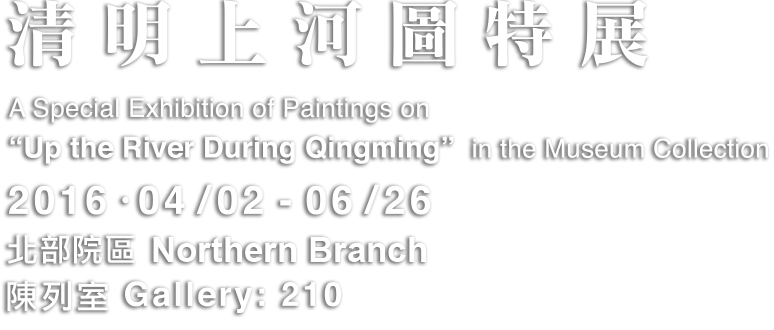In the collection of the National Palace Museum are eight handscroll paintings on the subject of "Up the River During Qingming." They can be divided into three categories: one attributed to the original Song dynasty artist, Zhang Zeduan (fl. early 12th c.); one attributed to the Ming dynasty painter Qiu Ying (ca. 1494-1552); and the other by Qing dynasty (1644-1911) court artists. In terms of structure and content, the first two ultimately trace back to Zhang Zeduan's original now in the Palace Museum, Beijing. Though copies or forgeries, they include new urban elements and period features that yield different appearances compared to the prototypical Song version.
Zhang Zeduan's "Up the River During Qingming" from the early 12th century in the late Northern Song period is universally recognized as one of the great masterpieces of Song genre painting. It depicts scenes of prosperity along the banks of the Bian River in Kaifeng, the Northern Song capital. With its realistic techniques in painting and legendary history in collecting, the scroll not only captured the attention of connoisseurs and collectors through the ages but also later became the focus of art-historical research in modern times. Often with numerous opinions but little agreement among scholars, "Up the River During Qingming" has even become a formal subject of study. Artists likewise adopted different perspectives, such as imitation and copying, leaving behind the innumerable versions extant today. Scholars believe that approximately a hundred versions exist nowadays in private collections and major museums around the world, demonstrating just how much influence "Up the River During Qingming" has exerted in Chinese art over the years.
The Qing court version of "Up the River During Qingming" is an 18th-century collaborative effort on the part of five artists at the Painting Academy: Chen Mei (1694-1745), Sun Hu, Jin Kun, Dai Hong, and Cheng Zhidao. The content of the painting is all-inclusive and its production refined and meticulous, integrating the specialties of the individual artists to rival the beauty of Zhang Zeduan's original. As for Shen Yuan's version of around the same period, it may differ from the Qing court painting in terms of material and coloring but throughout is almost identical in layout, objects, vehicles, and figures, offering a glimpse into how large handscroll projects were handled at the Qing Painting Academy.
The quality and quantity of paintings on "Up the River During Qingming" in the National Palace Museum collection are considerable, but these works have rarely been displayed together. To coincide with the Qingming Festival (also known as Tomb Sweeping Day) in early April, these eight scrolls in the Museum are being placed on display for the public to study and enjoy, creating a rare and sumptuous feast for the eyes. Visitors are hereby invited to appreciate the different ways in which painters of the Ming and Qing dynasties interpreted the classic theme of "Up the River During Qingming" in Chinese art history.
